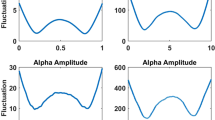Abstract
Brain potentials preceding voluntary movements, obtained after averaging single-trial EEG records synchronised with the start of movement, consist of slow potential shifts SPS in the negative direction mixed with faster components like ongoing EEG activity. Two hypotheses were tested: SPS could be presented by a sum of smooth function (trends) and weakly stationary processes (residuals); the residuals and the ongoing EEG activity preceding SPS could be described by the same class of autoregressive (AR) or autoregressive moving average (ARMA) models. The trend was estimated by comparing several approximating functions in the sense of least mean square error. The SPS residuals, after subtracting the trend and background EEG activity, were estimated using AR and ARMA models of different orders. These procedures were performed on brain potentials recorded from vertex to linked ear lobes of five subjects instructed to voluntarily press a button. As a result, the hypotheses were not rejected. The trend was best approximated by a hyperbolic function or Chebyshev's second order polynomial. AR models fitted both the SPS residuals and ongoing EEG activity well enough. In conclusion, SPS were characterised by three parameters of the smooth function plus a time parameter defined by the potential boundaries.
Similar content being viewed by others
References
Andersen, N. (1974) On the calculation of filter coefficients for maximum entropy spectral analysis.Geophysics,39, (1), 69–72.
Barrett, G., Shibasaki, H. andNeshige, R. (1986) Cortical potentials preceding voluntary movement: evidence for three periods of preparation in man.Electroencephal. Clin. Neurophysiol.,83, 327–339.
Box, G. E. P. andJenkins, G. M. (1970) Time series analysis.Holden-day, 323–327.
Childers, D. G., Aunon, J. I. andMcGillem, C. D. (1981) Spectral analysis: prediction and extrapolation.Crit. Rev. in Bioeng.6, 133–175.
Deecke, L., Grözinger, B. andKornhuber, H. H. (1976) Voluntary finger movement in man: cerebral potentials and theory.Biol. Cybern.,23, 99–119.
Isaksson, A. (1977) SPARK—a sparsely updated Kalman filter with application to EEG signals. Techn. rep. 120, Royal Inst. of Technology, Stockholm.
Kashyap, R. L. andRao, A. R. (1976)Dynamic stochastic models from empirical data. Academic Press, New York.
Kornhuber, H. H. andDeecke, L. (1964) Hirnpotentialänderungen beim Menschen vor und nach Willkürbewegungen, dargestellt mit Magnetbundspeicherung und Rückwärtsanalyse.Pflügers Arch. Ges. Physiol.,281, 52.
Kornhuber, H. H. andDeecke, L. (1965) Hirnpotentialänderungen bei Willkürbewegungen und passiven Bewegungen des Menschen: Bereitschaftspotential und reafferente Potentiale.Pflügers Arch. Ges. Physiol.,284, 1–17.
Libet, B. (1985) Unconscious cerebral initiative and the role of conscious will in voluntary action.The Behavioral and Brain Sci.,8, 529–566.
Neshige, R., Luders, H. andShibasaki, H. (1988) Recording of movement-related potentials from scalp and cortex in man.Brain,3, 719–736.
Pieper, C. F., Goldging, S., Jenny, A. B. andMcMahon, J. P. (1980) Comparative study of cerebral cortical potentials associated with voluntary movements in monkey and man.Electroencephal. Clin. Neurophysiol.,48, 266–292.
Popivanov, D. (1986) Computer detection of EMG edges for synchronisation of movement-related brain potentials.,64, 171–176.
Rumshisky, L. Z. (1971) Mathematical processing of experimental results. Nauka, Moskow (in Russian)
Vaughan, Jr.,H. G., Costa, L. D. andPitter, W. (1968) Topography of the human motor potential.Electroencephal. Clin. Neurophysiol.25, 1–10.
Author information
Authors and Affiliations
Rights and permissions
About this article
Cite this article
Popivanov, D. Time series analysis of brain potentials preceding voluntary movements. Med. Biol. Eng. Comput. 30, 9–14 (1992). https://doi.org/10.1007/BF02446187
Received:
Accepted:
Issue Date:
DOI: https://doi.org/10.1007/BF02446187




